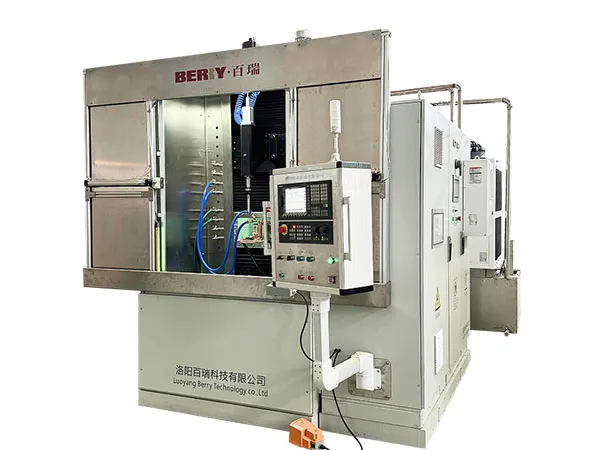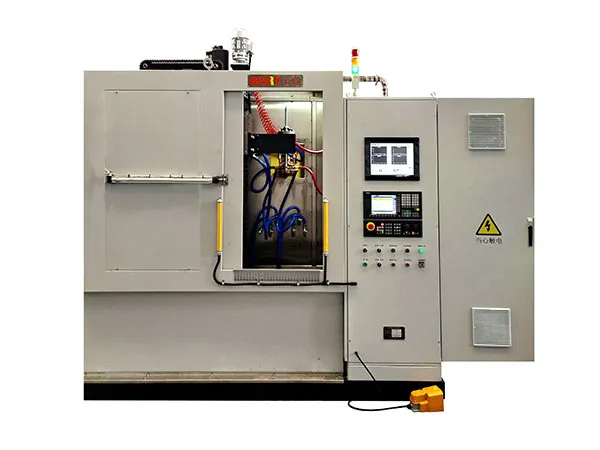time: 2025-04-17 06:17:00
Induction hardening is a non-contact, localized heat treatment process that uses electromagnetic induction to heat and harden specific areas of metal parts (e.g., gears, shafts, or bearings) without affecting the entire component.It combines two key principles: electromagnetic induction to generate heat and metallurgical transformation (hardening) through rapid cooling.

Electromagnetism: The process relies on Faraday's Law of Induction. When an alternating electric current (AC) flows through a conductor (the induction coil), it creates a fluctuating magnetic field around it.
Inducing Current in the Workpiece: When a conductive metal part (the workpiece, typically steel) is placed within this fluctuating magnetic field, the field induces electrical currents inside the workpiece itself. These are called eddy currents.
Generating Heat (Joule Heating): The metal workpiece has electrical resistance. As these strong eddy currents flow against this resistance, they generate intense heat very rapidly (based on the principle P = I²R, where P is power/heat, I is current, and R is resistance).
Skin Effect: High-frequency AC tends to concentrate the eddy currents near the surface of the workpiece. This is called the "skin effect." By controlling the frequency of the AC power supply, operators can control how deep the heat penetrates. Higher frequencies mean shallower heating, lower frequencies mean deeper heating.
Hysteresis Heating (Minor effect): For magnetic materials like steel below their Curie temperature, the rapidly changing magnetic field also causes internal friction as magnetic domains try to align themselves, contributing slightly to the heating. However, eddy currents are the dominant heating mechanism.
Heating to Austenitizing Temperature: The induction heating rapidly raises the temperature of the desired surface layer (or section) of the steel part above its critical transformation temperature (the austenitizing temperature, typically 750-900°C or 1400-1650°F, depending on the steel grade). At this temperature, the steel's crystal structure changes to austenite, which can dissolve carbon effectively.
Rapid Cooling (Quenching): Immediately after the target temperature is reached, the heat source is turned off, and the heated area is rapidly cooled (quenched). This is usually done by spraying it with a quenchant (water, oil, polymer solution, or sometimes air).
Martensite Formation: This rapid cooling prevents the austenite from transforming back into its softer, equilibrium structures (like pearlite or ferrite). Instead, it forces the carbon atoms to become trapped within a highly strained, body-centered tetragonal crystal structure called martensite. Martensite is extremely hard and brittle.
(Optional) Tempering: Because martensite is often too brittle for practical use, the hardened part is usually tempered afterward. This involves reheating it to a much lower temperature (e.g., 150-600°C or 300-1100°F) and holding it for a specific time before cooling. Tempering reduces brittleness and internal stresses while retaining most of the hardness.

Power Supply (Generator/Inverter): Converts standard mains electricity (e.g., 50/60 Hz) into high-frequency AC power (ranging from kHz to MHz). Modern units are typically solid-state and allow precise control over power output and frequency.
Induction Coil (Inductor or Work Coil): Usually made of copper tubing (often water-cooled because of the high currents flowing through it). The coil's shape and size are critical and are custom-designed to fit the specific part being hardened, ensuring the magnetic field is concentrated precisely where heat is needed.
Quenching System: Includes nozzles, pumps, tanks, filters, and heat exchangers to deliver the quenchant fluid precisely to the heated area immediately after the heating cycle. Sometimes the quench spray is integrated directly into the induction coil assembly (spray quench coil).
Work Handling System: Fixtures, conveyors, robotic arms, or turntables used to hold the workpiece securely and move it accurately relative to the induction coil and quench system. This ensures consistent positioning and repeatable results.
Control System (PLC/Computer): Manages the entire process: controls the power supply (power level, frequency, heating time), operates the work handling system, controls the quench cycle (timing, flow rate), and monitors process parameters for quality control.
Cooling System: Water circuits are needed to cool both the power supply electronics and the induction coil itself due to the significant heat generated during operation.

An induction hardening machine uses a high-frequency alternating current in a specifically shaped coil to create a magnetic field. This field induces eddy currents within the surface layer of a metal part placed inside or near the coil, causing it to heat up extremely rapidly. Once the desired surface layer reaches the correct hardening temperature, it is immediately quenched, transforming the steel structure into hard martensite. This creates a part with a very hard, wear-resistant surface while maintaining a tougher, more ductile core.